Article's Content
At Foundation we help some of the biggest names in B2B SaaS turn their websites into growth engines.
From increasing organic traffic by 500,000+ visits for a leading event marketing platform to helping a service management brand company win 87% first-page rankings within 6 months, our organic growth strategy drives results.
But between AI and major algorithm changes, the organic search landscape has changed. Drastically.
Sure, prospects still use Google search to find software. But they also rely on AI overviews for quick answers, ask ChatGPT for software recommendations, and confirm their top choices on Reddit.
While most companies use outdated SEO playbooks, we’re showing them how to expand their influence across Google, ChatGPT, Reddit, and AI overviews simultaneously.
SaaS SEO is evolving.
Generative Engine Optimization (GEO) represents the next phase of search marketing, where your content needs to perform across traditional search engines, AI platforms, and community discussions simultaneously.
Companies that evolve early will capture disproportionate market share as prospects research everywhere.
Today we’ll show you how to do it.
TL;DR: Evolving SaaS SEO for the Multi-Platform EraHere’s the approach we use to help our clients maintain visibility and drive leads across Google, AI platforms, Reddit, and generative search engines:
|
Understanding SaaS SEO in the AI Era
Search engine optimization has been a core part of growth strategies for SaaS companies for over a decade. Optimizing websites for improved performance in search engines (primarily Google) has helped propel a number of SaaS giants by:
- Increasing brand awareness through SERP dominance.
- Driving organic traffic to lead capture pages.
- Capturing new users for product-led companies.
At Foundation, we’ve worked with some of these giants and helped them produce results that C-Suites love:
More people on the website and more prospects in the pipeline.
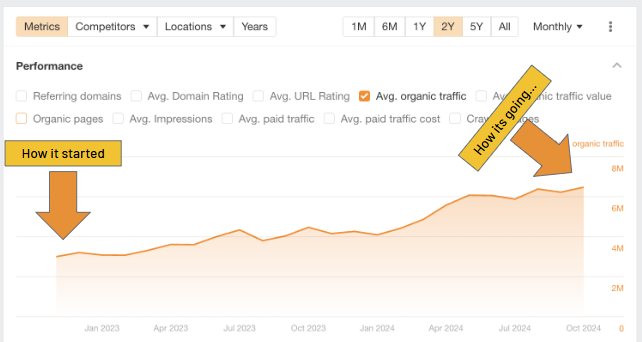
Even with constant shifts to Google’s algorithm, the pillars of SaaS SEO success have been stable for some time:
- On-Page SEO: Optimizing website elements that you control, like keywords, headers, and internal links, with a focus on improving content quality and relevance for both humans and search engines.
- Off-Page SEO: Increasing domain authority through backlink building, online research, and social media efforts. These external signals help improve search rankings and click-through rates.
- Technical SEO: Improving the underlying website structure and code elements like schema markup and canonicals to improve how search engines index and crawl your site.
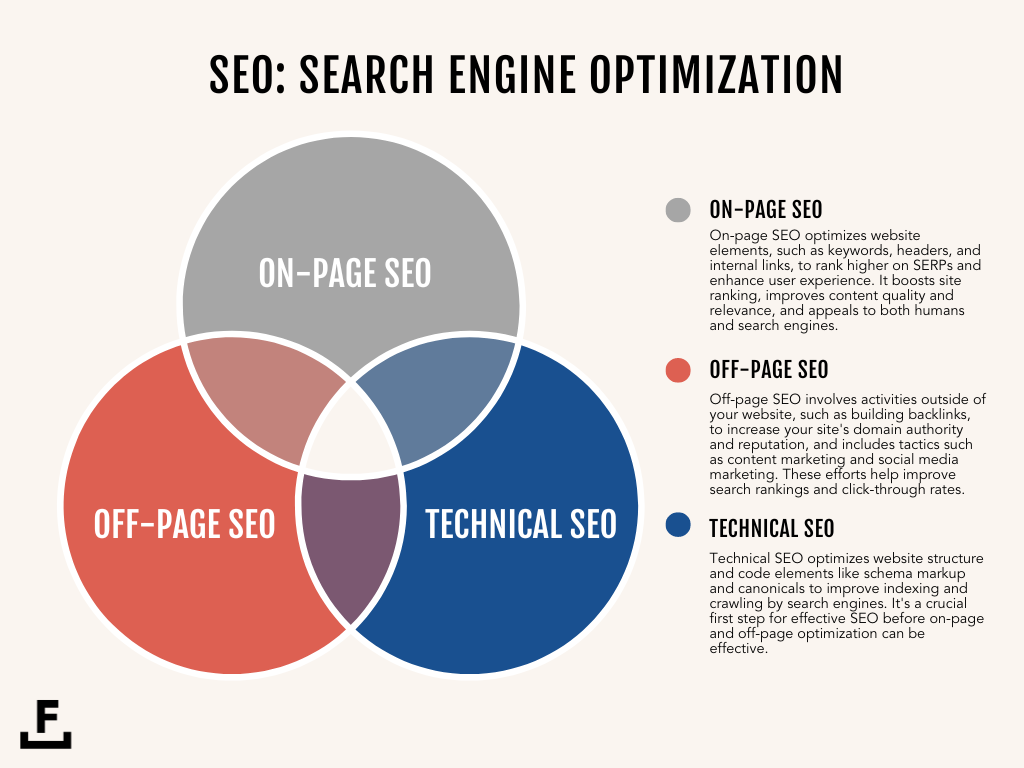
These practices are still relevant today, but there are some new variables in the mix. Mainly: generative AI.
Your target audience isn’t just going to the SERPs to find information on your company. They’re using tools like ChatGPT, Perplexity, and Gemini to get answers that are customer-tailored to their exact question.
For example, say you’re the co-founder of a niche startup based in Spain and you’re looking for the right platform to manage customer interactions. You might search something like “top CRM platforms for startups” and be greeted with a SERP full of paid ads, AI overviews, and SERP features.

With a tool like Perplexity, you can ask a search-enabled LLM a more specific question: “What is the best CRM platform for a pre-seed startup located in Spain?” And the results are quite different from the traditional Google Experience:

Not only do the references and citations change, but the response is much more personalized and contextually relevant, referencing key regional details like the GDPR.
To maintain both brand visibility and referrals in this expanded search ecosystem, companies need to embrace generative engine optimization (GEO).
Search Beyond Google: Generative Engine Optimization
GEO is the process of optimizing your digital content to maximize visibility and influence in AI-powered platforms like ChatGPT, Claude, Gemini, Perplexity, and Google’s AI Overviews.
Think about it like this: GEO helps your brand become the go-to source when AI engines generate responses to user queries about your industry, products, or expertise.
When someone enters a relevant prompt into one of these AIs, GEO increases the likelihood that your content will be referenced, cited, or featured in the AI’s response.
GEO vs SEO: An Evolution, Not a Revolution
At this point, it’s important to note: this isn’t a conversation about SEO vs GEO. Both processes attempt to improve the visibility of your content in search-based interfaces. GEO is just SEO with an expanded scope. It’s an evolution of the same fundamental principles you already know.
In fact, search engines and generative search are similar enough that they often produce the same sources.
Semrush recently compared the SERP results and different AI citations for 5,000 different keywords. They found that domains and URLS from AI Mode, AI Overviews, and Perplexity overlap extensively with the top 10 results in Google search.

The extensive overlap suggests that strong SEO fundamentals—quality content, technical optimization, authority building—directly improve your GEO performance. Your existing SEO work is the foundation.
That said, it’s not a complete overlap between SEO and GEO.
While Google focuses on traditional ranking factors, AI engines process and cite information differently. And as you can see from ChatGPT’s lower overlap figures in the data above, not all AIs pull from Google’s top results equally.
This is why GEO requires additional tactics beyond your core SEO strategy.
GEO Tactics: What’s New and Different
Beyond the on-page, off-page, and technical SEO fundamentals, SaaS brands need to prioritize GEO tactics that have the best chance of increasing brand visibility across AI tools.
Based on what we’re seeing from the current state of AI tools, this includes:
- Building a strong technical foundation: Maintaining SEO fundamentals while also implementing llms.txt files and ensuring content is machine-readable for LLM crawling and processing.
- Establishing content authority: Creating expert author pages, including statistics and quotations, using technical terminology, and establishing EEAT credibility signals.
- Prioritizing strategic content types: Doubling down on comparative listicles, informational posts with opinions, instructional resources, and content with relevant query modifiers.
- Engaging in multi-platform distribution: Publishing across UGC platforms like Quora, Reddit, LinkedIn, and YouTube to maximize citation opportunities from LLMs.
- Investing in AI citation tracking: Monitoring LLM visibility, tracking brand mentions in AI responses, and measuring authority building across multiple generative engines.
These GEO tactics address new realities like the increasing importance of Reddit and the impact of AI overviews on search behavior (like the rise in zero-click searches).
And that’s a big deal considering how people search for information online is changing dramatically.
Why GEO Matters for SaaS Companies
GEO is important to SaaS because people are using more than just the Google SERPs to find information about software:
57% of people said they have used LLMs to get information about products and services, according to recent survey results out of Elon University. Plus, nearly a quarter of them say they use AI mainly for work.
While Google is still the go-to for this type of commercial search intent, it’s clear AI now joins social media platforms and community forums as a key player in the decision-making process.
And there’s one community platform that’s especially important for GEO: Reddit. Not only is it dominating the SERPs, but the sentiments from popular posts now shape AI responses.
When prospects ask ChatGPT or Perplexity about software solutions, the AI draws from the same community discussions and authentic content that influences traditional search results. This means GEO strategies that ignore user-generated content and community engagement often fall short.
Companies that aren’t optimized for these new search features are simply invisible when prospects search for software using LLMs.
From SaaS SEO to SaaS GEO: The Foundation Method for Search Success in the AI Era
At Foundation, we’ve spent the past year helping SaaS companies navigate the transition from traditional SEO to comprehensive GEO strategies. What we’ve learned is that updating the SEO checklist alone isn’t enough—you need to expand your approach to search marketing.
Today we’ll look at 4 of the key components to our method for GEO success:
- Advanced keyword research that spans all platforms
- Content strategies optimized for both human readers and AI extraction
- Multi-platform engagement that builds authentic authority
- Technical foundations that ensure AI engines can understand and cite your content effectively
This expanded approach will help you capture prospects regardless of where they search for SaaS vendors.
1) Keyword Research is the Foundation of SEO and GEO Success
Once upon a time, keyword research assumed people only use search engines like Google and Bing. But that’s not true anymore.
The search journey is now spread across multiple platforms. That means your target audience might use:
- AI Overviews for quick, informational answers
- ChatGPT and Perplexity for deeper mid-funnel research
- Reddit for customer experiences and decision-making
They’re using the same keywords, but the number of platforms they search on has expanded dramatically.
To help our clients stay competitive in this fractured search space, we’ve taken the keyword research process we use to rank at the top of the SERP for some of the biggest names in SaaS and adapted for this new reality.
Here’s the 4-step process we use for GEO-informed keyword research:
Step 1: Understand What Your Customers Search and Competitors Target
We start with the fundamentals because they still matter. Using tools like Ahrefs, Semrush, and Google Keyword Planner, we identify:
- Search volume: How many people are searching for specific terms monthly
- Keyword difficulty: How competitive each term is to rank for
- SERP features: Whether queries trigger AI overviews, featured snippets, or other features
- Seasonal trends: When demand peaks for specific solutions
In our work with a large event marketing platform, we used this exact type of keyword research alongside a technical SEO audit to develop a content optimization campaign for over 250 underperforming pages on their site.
After over a year and a half of actioning this strategy, we’d increased their share of top 3 and top 10 ranking keywords by the thousands.

The result? An increase of over 500,000 organic visits to their website.
But here’s where we differ from traditional approaches: we don’t stop at search volume. High-volume keywords mean nothing if AI overviews are satisfying user intent without click-throughs, or if your prospects are actually researching on different platforms entirely.
Step 2: Find Out What the LLMs Say About You
This is where our approach gets unique. We test keyword variations across ChatGPT, Claude, Perplexity, and other AI platforms to understand:
- Brand mention frequency: How often do our clients appear in AI responses versus competitors?
- Context quality: Are mentions positive, neutral, or negative?
- Response triggers: Which query variations generate the most favorable mentions?
- Gap identification: Where are competitors dominating AI recommendations?
LLM mentions are something we’re starting to track for our clients as well as the Foundation brand itself. With the Semrush AI Toolkit we can see how frequently our brand name is mentioned by different AI tools in relation to our competitors as well as the sentiment of those mentions.
One thing we’ve learned is that performance can vary dramatically across tools. For instance, in the last week Foundation marketing had a 5% market share of agency mentions from ChatGPT and a 14% share of mentions on Perplexity.

This variation reveals valuable information you can exploit—and it’s exactly what we track through our Generative Engine Optimization audits.
Using tools like Profound, we monitor visibility across different AI models in real-time, tracking not just overall market share but also which domains get cited most frequently in AI responses.
When we dig into the citation data, we often discover that competitors aren’t just winning on content quality—they’re getting sourced because they’ve built relationships with the publications and platforms that AI models trust most.
The result is that you stop playing defense against AI and start using it as a competitive intelligence tool that shows you exactly where to win the conversations that drive pipeline—whether that’s through strategic content placement, digital PR efforts, or community engagement on platforms where your prospects are actively seeking solutions.
Step 3: Mine Reddit Discussions for Voice of Customer Gold
Reddit has fundamentally changed the BoFu landscape for B2B SaaS.
It now ranks organically for tens of millions of commercial intent keywords and generates nearly 200 million organic visits for bottom-of-funnel queries. And it’s doing this while outranking review sites like G2 and Capterra.
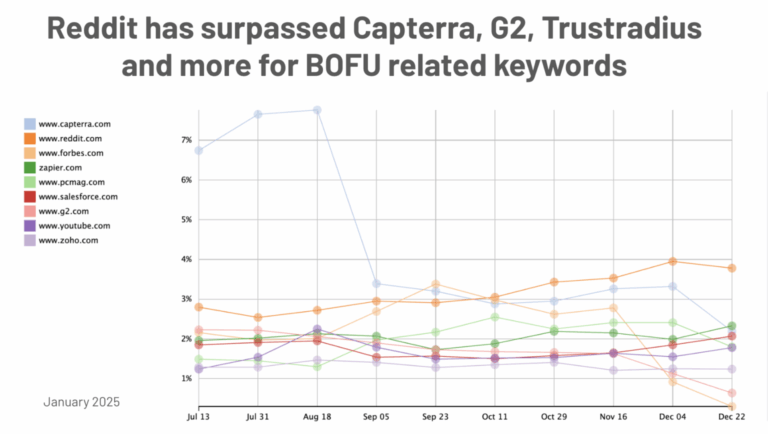
These Reddit threads are also coming up in AI-generated answers, which means your prospects are hearing from others long before they hear from you.
This creates what we call “dark conversions”—buyers read Reddit threads, open new tabs, and land on your site without any traceable attribution. These discussions happen in spaces your analytics can’t reach, yet they’re driving high-stakes purchasing decisions.
Our Reddit Discussion Mining process follows the first two steps of Ross’s “Lurk, Listen, Leap” framework. This helps you regain visibility into these hidden conversion pathways:
Lurk: Identify Where High-Intent Discussions Happen
- Map your brand’s Reddit footprint using “[brand name] + reddit” searches
- Use tools like Ahrefs to find subreddit URLs ranking for your product keywords
- Identify primary communities where prospects ask for recommendations
- Locate industry-specific forums where buying decisions are discussed
- Discover geographic or niche communities relevant to client positioning

Listen: Learn What Audiences Really Think About Your Product
- Analyze individual posts and comments to uncover authentic customer sentiment
- Track what problems people are actually trying to solve
- Document which brands get recommended and why
- Capture the exact language prospects use when describing their needs
- Map common objections, praise points, and unmet needs
- Identify conversation gaps your clients could fill

Strategic Intelligence Gathering:
- How is your brand perceived versus competitors in community discussions?
- Which competitors have the strongest community advocates?
- What pricing, onboarding, or support issues surface repeatedly?
- Where are the opportunities for authentic engagement?
For this process, we use a combination of tools, including traditional keyword research platforms like Ahrefs and STAT, Reddit’s internal search filters, and Reddit-specific intelligence tools like GummySearch.
Step 4: Track How Intent Varies Across Platforms
The dark attribution crisis is a reporting problem; but it’s a strategic blindness that’s costing you competitive opportunities.
While you’re optimizing Google Ad spend, your prospects might be getting swayed by Reddit threads you’ve never seen. While you’re perfecting demo conversion rates, competitors could be dominating AI recommendations for your core keywords.
Intent mapping solves both problems simultaneously. It reveals the hidden research pathways your prospects actually use AND exposes where competitors are vulnerable across different platforms.
More importantly, it turns all that Reddit intelligence from Step 3 into actionable competitive strategy.
Here’s how we map intent across the platforms that matter for B2B software research:
Google Intent: Traditional search behavior
- Informational: “What is project management software?”
- Commercial: “Best project management tools 2026”
- Transactional: “Asana vs Monday pricing”
AI Intent: Quick answers and recommendations
- Synthesis queries: “Compare project management software features”
- Recommendation queries: “What’s the best project management tool for small teams?”
- Problem-solving queries: “How to manage remote team projects”
Reddit Intent: Peer validation and real experiences
- Experience queries: “Anyone used [tool] for [specific use case]?”
- Recommendation requests: “Looking for alternatives to [current tool]”
- Problem discussions: “Struggling with [specific challenge], what works?”
Tools We Actually Use (And Why)
Knowing which terms your audience is searching for is still the first step. But now you need to look beyond the SERPs to validate that information.
Here are some of the tools we’re using for a more comprehensive keyword research approach:
- SEMrush AI Toolkit: Provides LLM-informed keyword suggestions that show what AI engines prioritize. We use this to identify content gaps and opportunities for AI citation.
- STAT by Moz: Essential for multi-platform SERP tracking. We monitor how keywords perform across traditional results, AI overviews, Reddit threads, and other SERP features simultaneously.
- Ahrefs: Still the gold standard for traditional keyword research and competitor analysis. We use it to understand the competitive landscape and identify content opportunities.
- HubSpot AI Search Grader: Free tool that helps us assess content optimization for AI-powered search engines and provides specific improvement recommendations.
This four-step keyword research process does more than identify search terms—it maps the complete competitive intelligence landscape that modern B2B software buyers navigate. You now understand not just what your prospects search for, but where they search, how competitors show up in each space, and where the biggest attribution gaps exist in your pipeline.
But keyword research is just the foundation. The real competitive advantage comes from creating content that dominates these conversations across every platform where decisions get made.
In the next section, we’ll show you exactly how to turn this intelligence into a content strategy that captures attention, builds authority, and drives pipeline—whether prospects find you through Google, get your brand recommended by AI, or discover you through authentic Reddit discussions.
2) Content That Ranks Everywhere: Our SaaS Money Pages Strategy
While most SaaS companies are panicking about AI stealing their organic traffic, the smartest players are recognizing a massive opportunity:
AI engines are actually making authoritative content more valuable, not less.
Here’s why: Recent research from Josh Blyskal and the Profound team reveals that 32.5% of all LLM citations come from comparative listicles, followed by blog posts and opinion pieces at nearly 10%.
This isn’t coincidence—it’s because B2B software buyers are constantly evaluating options, and AI engines need comprehensive comparison data to provide helpful responses.
Remember: generative AI is even more reliant on authoritative sources than traditional search ever was.
In a Princeton GEO study, researchers found that citing credible sources and adding expert quotes improved AI citation rates by 30-40% while also delivering a 15-20% increase in traditional search performance.
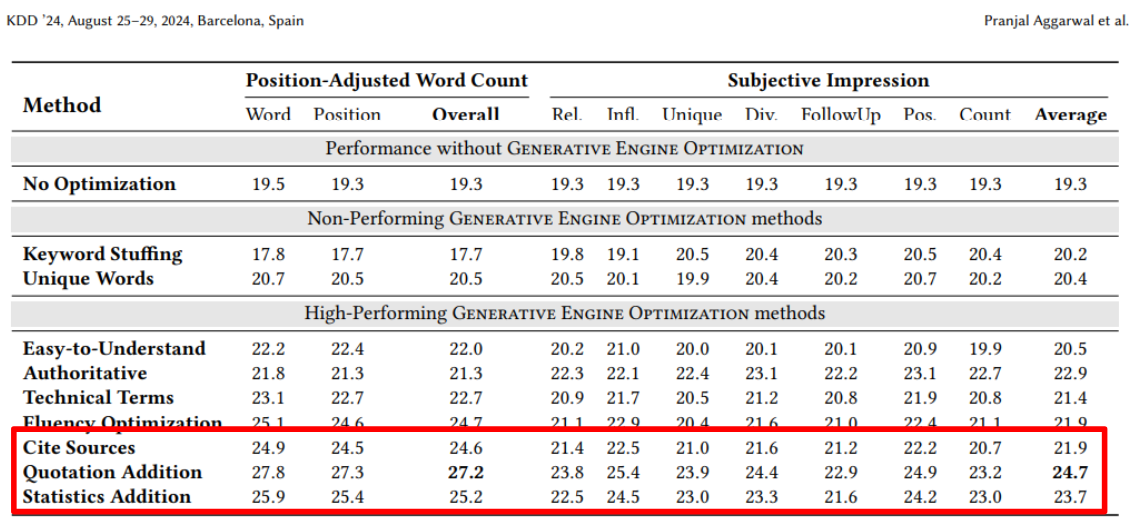
This creates a compounding advantage for SaaS companies that understand the new rules.
The same content structure that gets your brand recommended by ChatGPT also dominates Google SERPs and captures prospects researching on Reddit. You’re not just building an SEO moat—you’re building an intelligence moat that competitors can’t easily replicate.
But here’s the catch: creating content that serves both human decision-makers and AI extraction algorithms requires a fundamentally different approach than traditional SEO. You need enterprise content marketing that builds authority at scale while providing the contextual depth that AI engines require for accurate recommendations.
Here’s the framework we use to develop content strategies that capture pipelines across every research channel your prospects use.
1. Keyword Integration with Contextual Depth
Traditional SEO focuses on keyword placement—titles, headers, first paragraphs. That still matters, but GEO demands much more contextual information around those keywords.
Strategic Placement for Traditional SEO:
- Primary keyword in title tag and H1
- Secondary keywords in H2 and H3 headings
- Natural variations throughout body content
- Keywords in meta descriptions and image alt text
Rich Context for AI Parsing:
- Supporting data and statistics that validate claims
- Real-world examples and use cases
- Expert quotes and industry insights
- Historical context and trend analysis
So, instead of just writing “Best CRM Software for Small Businesses,” create comprehensive guides that include market analysis, feature comparisons, pricing breakdowns, implementation timelines, and success stories.
This gives AI engines multiple data points to reference when generating responses.
2. Authority & Citation Optimization
AI engines prioritize content from recognized authorities when generating responses. We establish this authority through strategic citation and reference strategies.
Academic and industry references:
- Link to credible research studies and industry reports
- Reference government publications and regulatory guidelines
- Cite well-respected industry publications and thought leaders
- Include data from reputable survey sources and market research firms
Statistical integration with proper sourcing:
- Always attribute statistics to original sources
- Use recent data (within 12-18 months when possible)
- Provide context around data points
- Explain methodology when relevant
Expert quotes and first-hand experience:
- Include quotes from industry experts and thought leaders
- Add insights from client success stories and case studies
- Share behind-the-scenes insights from actual implementations
- Provide commentary from our team’s experience
These EEAT signals have been an important part of SaaS SEO for years. We’ve covered how brands like Bankrate, 6Sense, and other industry leaders apply their in-house expertise to boost authority signals. These practices are only going to get more important as AI usage increases.

3. Structure for Skimmability & AI Extraction
Content needs to work for both human readers who scan quickly and AI engines that parse systematically.
Clear H2/H3 hierarchy for navigation:
- Logical flow that answers user questions progressively
- Headers that could stand alone as mini-topics
- Consistent formatting that AI can easily parse
- Descriptive headers that include relevant keywords naturally
Lists and tables for easy parsing:
- Bullet points for features, benefits, and key takeaways
- Numbered lists for step-by-step processes
- Comparison tables for feature analysis
- Summary boxes for quick reference
TL;DR summaries and key takeaways:
- Executive summary at the beginning for quick understanding
- Key takeaway boxes throughout longer sections
- Summary paragraphs that could stand alone
- Clear conclusions that AI can extract as definitive answers
Schema markup for machine understanding:
- FAQ schema for common questions sections
- How-to schema for process-oriented content
- Article schema for thought leadership pieces
- Review schema for product evaluations
Content Types That Consistently Perform
Just like the Profound study, an XFunnel analysis from earlier this year found that product-related content is frequently cited by generative AI. In this case, making up between 46% and 70% of all sources.

SaaS comparison pages have been a major part of our work over the past few years, with the types below being particularly effective at driving MoFu and BoFu traffic:
- “[Tool] vs [Tool]” Comparisons: Direct head-to-head comparisons between specific solutions, focusing on real differentiators rather than marketing claims.
- “Best [Category] for [Use Case]” Lists: Comprehensive roundups that address specific user needs rather than generic “best of” lists.
- “[Problem] Solutions” Guides: Problem-first content that explores multiple solution approaches, positioning clients as preferred options.
- “[Tool] Alternatives” Pages: Content targeting prospects already using competing solutions and considering switches.
These money pages were a key component of our work with a client in the field service management space. This SaaS brand was up against some stiff competition, but was able to use these comparison pages to:
- Rank for over 3,300 variations of competitor keywords and comparison phrases
- Drive over 80,000 high-intent visits from their blue-collar target audience ($150k value)
- Use these assets primary landing pages for the demand generation team’s paid campaigns
Considering the results from Profound’s study on AI citation, there’s also a high likelihood that these pages show up in AI answers.
By creating content that serves all these research behaviors simultaneously, our clients capture prospects regardless of how they prefer to research and evaluate solutions.
3) Multi-Platform Search Optimization Strategy
We talked earlier about how the likes of G2 and Capterra are losing their grip on B2B software research, while Reddit marketing has emerged as the dominant force in bottom-of-funnel decision-making.
It’s a massive behavioral shift and SaaS brands that ignore it will miss critical conversations that shape purchase decisions.
Modern buyers, especially younger Millennial and Gen Z decision-makers, have grown skeptical of polished vendor pages and curated review platforms. Instead, they’re seeking authentic peer experiences:
- Honest discussions about implementation challenges
- Peer recommendations from similar use cases
- Unfiltered feedback about customer support experiences
- Real-world pricing and negotiation insights
- Authentic comparisons based on actual usage
The shift becomes even more significant when you consider how AI tools are amplifying Reddit’s influence. Generative engines like ChatGPT, Perplexity, and Gemini now surface Reddit threads in response to high-intent questions, with Reddit being cited in more than 12 million generative searches.
This means Reddit discussions shape buying decisions in two ways: directly through human readers, and indirectly through AI training data that powers the next generation of search results.
With that in mind, here’s how we help clients establish a footprint on this critical platform.
Our Reddit Strategy for SaaS Clients
Our approach focuses on two complementary tactics: creating valuable native content and strategically engaging in existing high-value conversations.
Tactic 1: Native Content Creation
The first step is to identify the right subreddits. We start by mapping our clients’ audience segments to relevant communities:
- Primary targets: Industry-specific subreddits (r/marketing, r/sales, r/productivity)
- Vertical-specific: Use case communities (r/remotework, r/smallbusiness, r/nonprofit)
- Geographic: Location-based communities for local market penetration
- Tool-specific: Competitor communities where switching conversations happen
After the research and strategy phase, we begin content production. The key to Reddit success is authentic value, not promotion. Our content follows the 90/10 rule:
- 90% valuable insights: Genuine help, frameworks, and expertise sharing
- 10% subtle positioning: Natural mentions when directly relevant
- Zero hard sells: Let expertise and helpfulness build authority organically
Here’s an example of an informative post we created for a client in the web hosting space to help establish their brand as an education resource for Redditors:

Reddit is a notoriously tricky platform to drive positive engagement on, so make sure you’re up to date on how best to leverage reddit for enterprise companies.
Tactic 2: Strategic Thread Engagement
This is where our SERP-first approach becomes powerful. We use STAT and ahrefs to identify Reddit threads already ranking for our clients’ target keywords, then engage strategically to strengthen those threads’ positions while building client authority.
Our Step-by-Step Process:
- Identify High-Value Ranking Threads: Using STAT, we find Reddit discussions ranking in top 10 for target keywords
- Analyze Existing Conversation Quality: We review responses to identify gaps in information or perspectives
- Craft Valuable, Non-Promotional Contributions: Our responses focus on addressing specific gaps with helpful information
- Monitor and Nurture Engagement: Track upvotes and response quality as engagement indicators
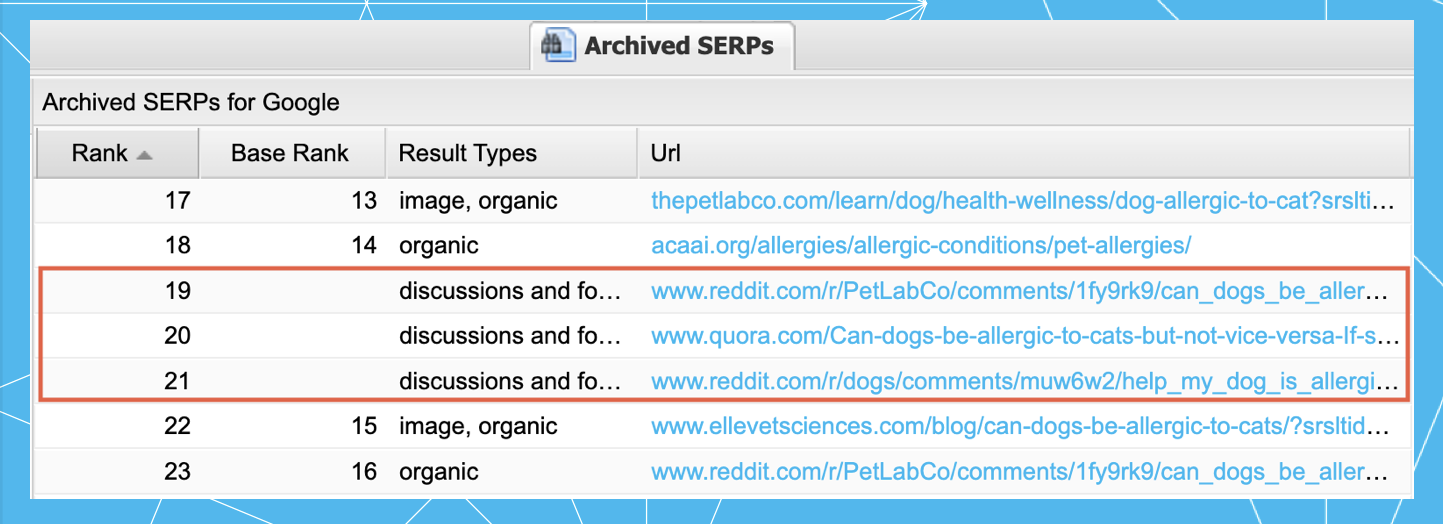
You may be thinking, “I thought we were talking about SaaS SEO and driving traffic to my site, why are we talking about Reddit now?” A glimpse of the results from one of our InsurTech clients shows this connection more clearly.
After months of engaging in and driving conversations surrounding small business insurance in relevant subs from r/generalcontractor to r/FoodTrucks, the Reddit wins are starting to translate into pageviews—over 2,000 so far this year.
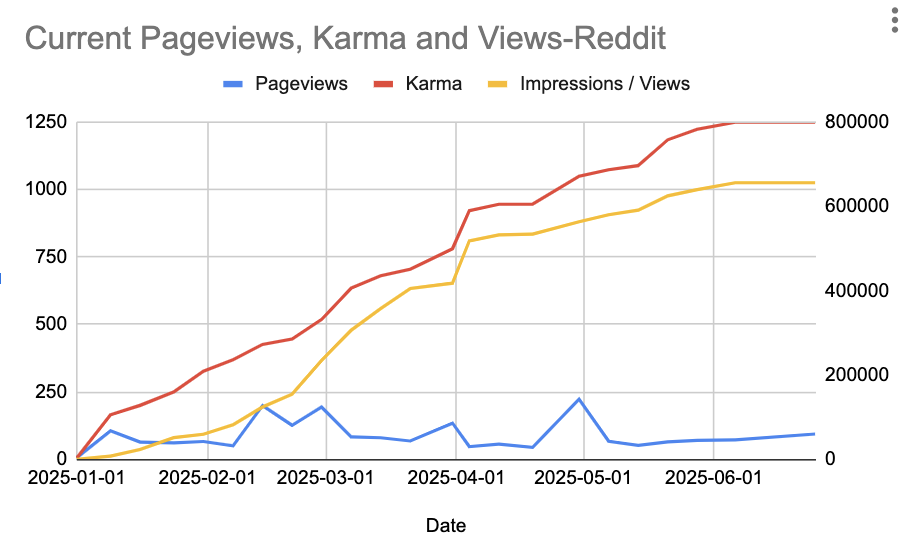
Although it seems like a small amount of traffic, these are high-intent visitors who found their way from authentic community discussions to conversion-oriented pages on the brand’s site.
Best of all? These results compound as the brand’s presence on Reddit grows.
Digital PR for AI Authority
While AI’s are certainly influenced by UGC and community forums, there’s no denying that some of the “older” SEO authority signals are still relevant.
AI engines prioritize content from recognized experts and authoritative sources. Our digital PR strategy focuses on establishing our clients as go-to industry experts.
Expert Quote Strategy:
- Guest posting: Sharing insights in relevant publications
- Trend commentary: Providing insights on industry developments
- Research contributions: Sharing data and analysis for industry reports
- Breaking news response: Offering expert perspective on significant industry events
Podcast and Media Appearances:
- Industry-specific shows: Targeting podcasts our clients’ prospects actually listen to
- Thought leadership topics: Discussing broader industry trends, not just product features
- Authentic storytelling: Sharing real challenges and solutions, not marketing messages
- Follow-up content: Creating related content that extends the conversation
The goal here is to help our clients become default experts that prospects encounter regardless of how they research.
A prospect researching solutions might find a Reddit thread where our client provided helpful insights, see an AI overview that cites our client’s content as authoritative, discover a podcast episode where our client discussed industry trends, and read an industry report where our client contributed expert analysis.
By the time they reach a sales conversation, they already view our client as a trusted authority rather than just another vendor option.
4) Technical SEO for the AI Era
Technical SEO used to be about helping Google crawl and index your pages efficiently.
That foundation still matters, but AI engines don’t just crawl like traditional search engines—they parse content for meaning, context, and relationships. This means technical SEO now includes optimization for machine understanding, not just machine discovery.
Here’s how we’re blending the old with the new:
What’s Changed in Technical SEO
Traditional technical SEO focused on helping search engines find and index your content. Modern technical SEO ensures that AI engines can understand, extract, and cite your content when generating responses for user queries.
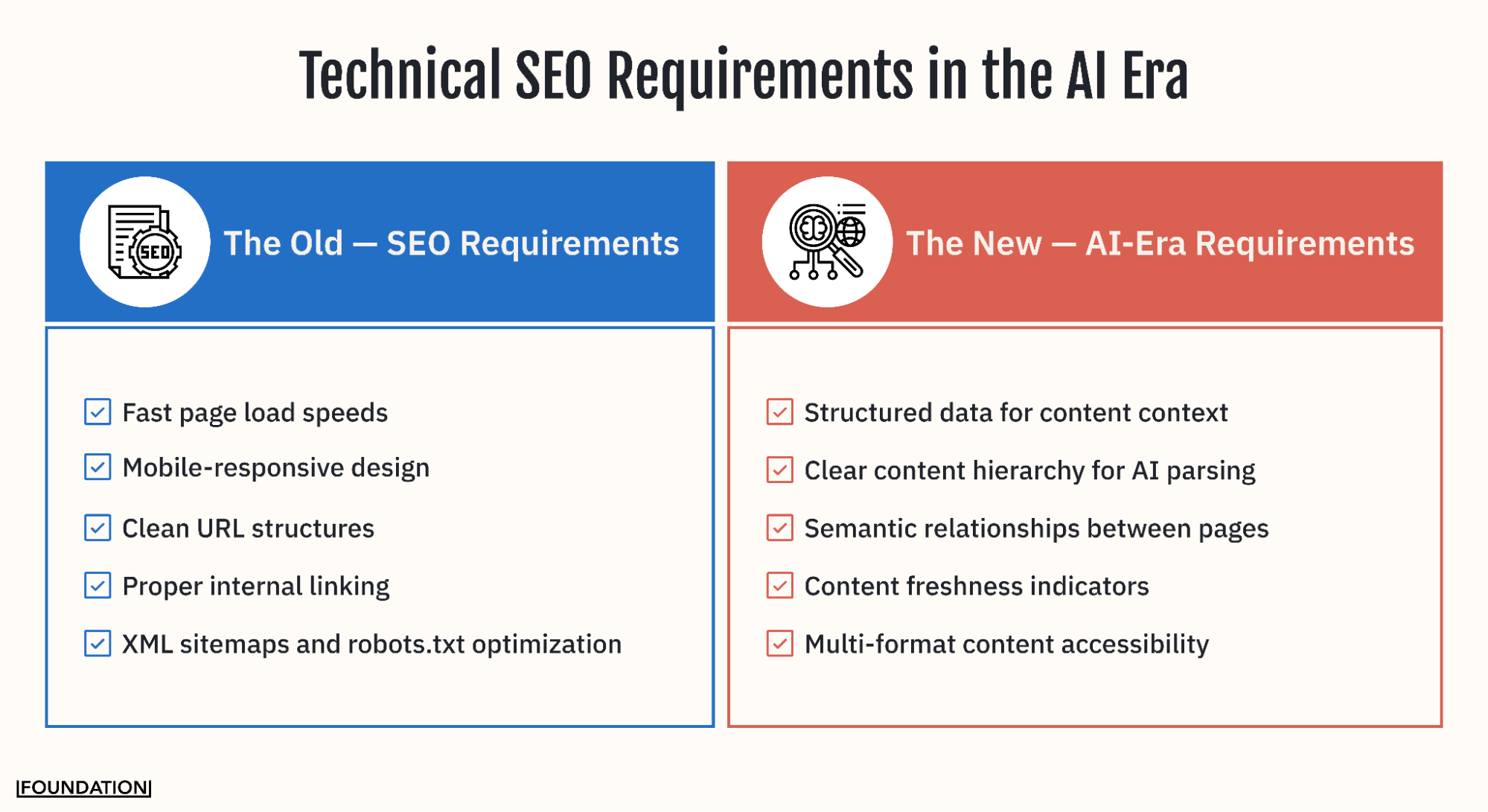
Here are some of the most important technical requirements to keep an eye for 2025 and beyond:
- Schema Markup Implementation
Schema markup has evolved from “nice to have” to “essential for AI visibility.” Different content types require specific schema implementations:
- FAQ Schema for Common Questions: Essential for content that answers prospect questions. AI engines frequently pull from properly marked FAQ sections when generating responses.
- How-to Schema for Process Content: Critical for educational content that explains implementation, setup, or best practices.
- Article Schema for Thought Leadership: Helps AI engines understand author expertise and content authority for citation purposes.
- Product Schema for SaaS Offerings: Enables AI engines to understand features, pricing, and capabilities for recommendation generation.
- Organization Schema for Company Information: Establishes entity relationships that help AI engines understand your company’s expertise areas.
Google Search Central provides both a Rich Results Test and Schema Markup Validator which show you which rich results your content can generate before testing your structured data.
- Site Speed for AI Crawling
AI engines process content differently than traditional crawlers, often requiring more intensive analysis. Slow sites get less thorough AI analysis, reducing citation opportunities.
Core Web Vitals Optimization:
- Largest Contentful Paint (LCP): Under 2.5 seconds
- First Input Delay (FID): Under 100 milliseconds
- Cumulative Layout Shift (CLS): Under 0.1
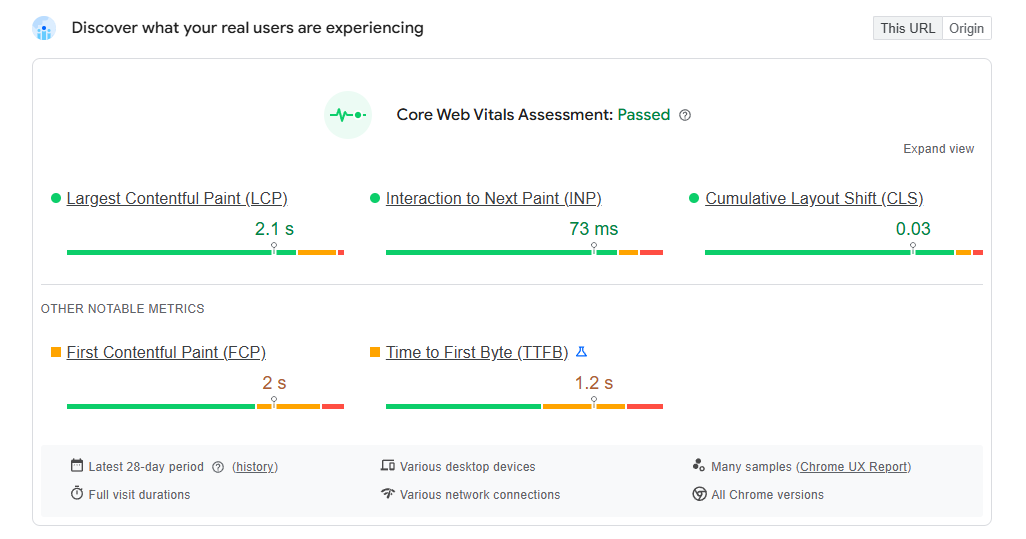
AI-Specific Speed Considerations:
- Content Above the Fold: Most important information accessible without scrolling
- Progressive Loading: Key content loads first, supporting elements load progressively
- Structured Content First: Headers and schema markup load before decorative elements
- Mobile-First AI Optimization
AI engines prioritize mobile-optimized content since most queries now happen on mobile devices.
Beyond Responsive Design:
- Touch-friendly interfaces: Easy navigation for mobile users
- Readable without zooming: Proper font sizes and contrast
- Fast mobile loading: Optimized images and compressed resources
- Voice search compatibility: Content structured for conversational queries
- Internal Linking for AI Understanding
AI engines use internal links to understand content relationships and topic authority. Strategic internal linking helps establish topical clusters that AI engines recognize as comprehensive resources.
Semantic Link Relationships:
- Topic clusters: Related pages linked through descriptive anchor text
- Content hierarchies: Clear parent-child relationships between pages
- Cross-references: Relevant pages linked when topics naturally overlap
Anchor Text Optimization:
- Descriptive and contextual: “Learn about project management best practices” vs. “Click here”
- Keyword relevant: Natural inclusion of target keywords in anchor text
- Relationship indicators: Clear connection between linked content
The Foundation Method for GEO success integrates four critical components that work together to build comprehensive search authority. The elements mentioned above create a compounding effect that results in sustainable search authority, helping companies build competitive moats that become increasingly difficult to replicate as search continues to evolve.
Measuring Success: What We Track for SaaS Clients
Modern SaaS buyers don’t follow linear paths from search to conversion.
The established SEO metrics like impressions, traffic, click-through rates, and average search position helped paint part of the picture, but the journey is getting more and more complicated.
With AI overviews, Reddit, and the increasing number of search-ebabled LLMs in the mix, we’re changing how we define and track search success for our clients. Our measurement approach acknowledges this reality by tracking performance across every touchpoint where prospects encounter our clients’ brands.
Of course, the standard SaaS SEO metrics are still critical because they show how well your owned content performs on Google. That’s why we still track:
Google Search Console Data:
- Organic Traffic Trends: Monthly organic traffic growth and seasonal patterns
- Click-Through Rate Analysis: CTR improvements from title and meta description optimization
- Keyword Performance Tracking: Average position changes for target keywords
- Core Web Vitals Monitoring: Site speed impact on search performance
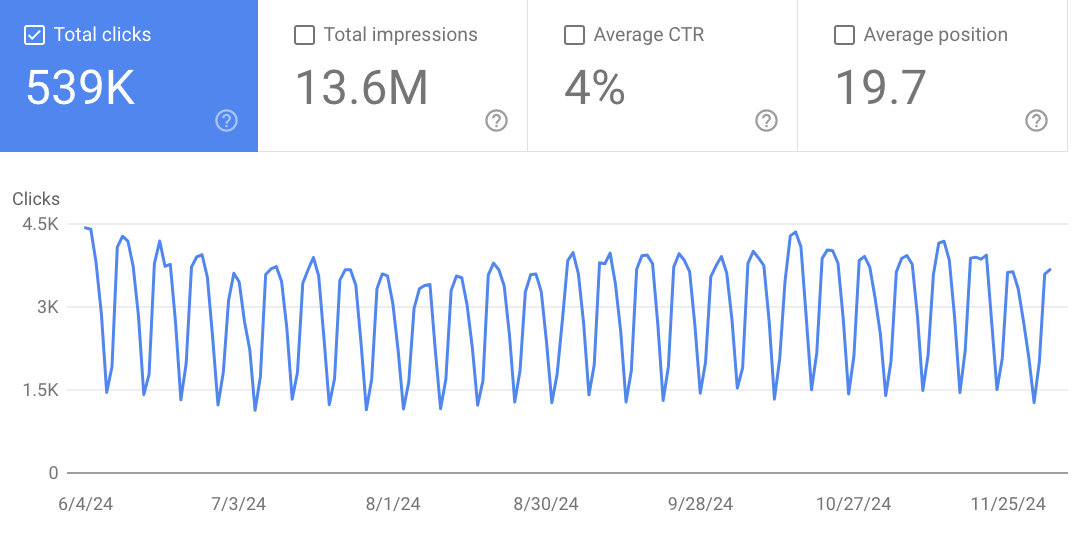
Keyword Position Tracking: We use STAT to monitor rankings across 50+ target keywords per client, tracking not just positions but also SERP feature appearances and competitor movements.
Backlink Profile Development:
- Domain authority growth from quality link acquisition
- Referring domain diversity showing broadening authority
- Link building campaign ROI and relationship development
Modern Metrics (Increasingly Critical)
These newer metrics capture how prospects interact with your brand across the evolving search landscape:
AI Overview Tracking:
- Keyword Queries Triggering AI Overviews: Using STAT, we monitor which of our clients’ target keywords generate AI overview results
- Client Mention Analysis in AI Responses: We manually test key industry queries across ChatGPT, Claude, Perplexity, and other AI platforms
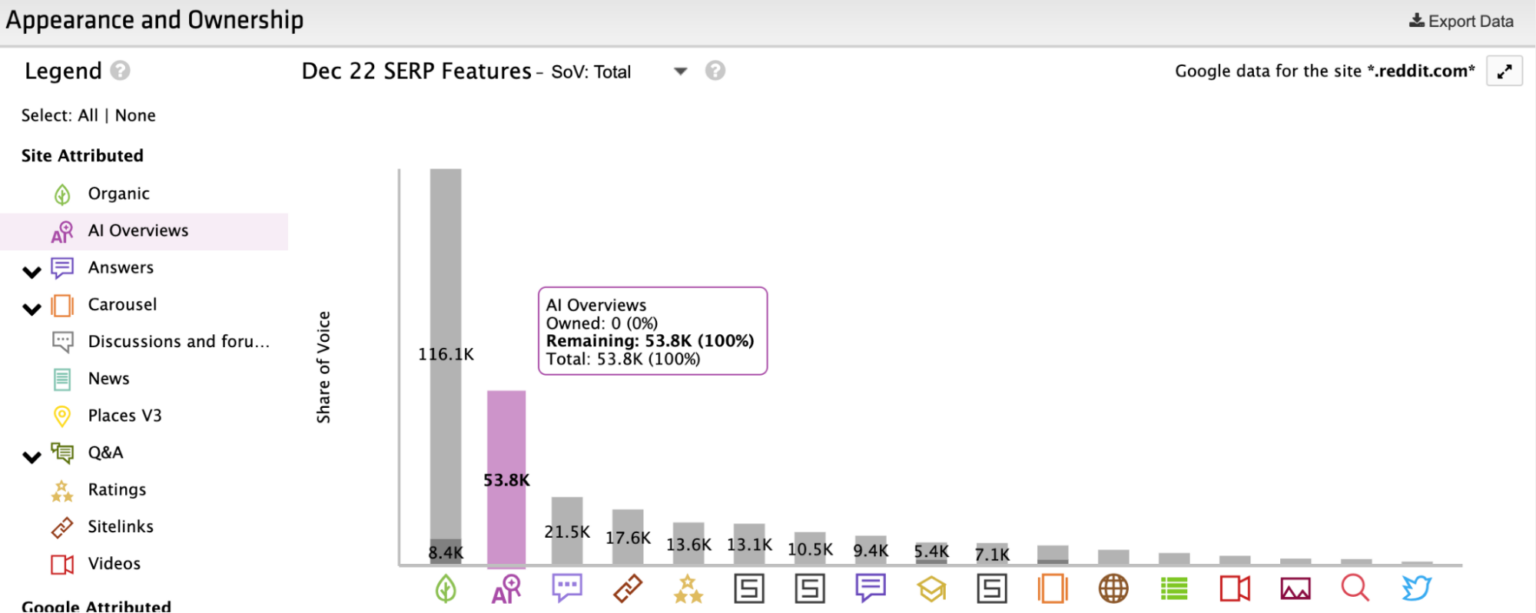
Reddit Performance Monitoring:
- Brand Mention Sentiment Analysis: Frequency of positive, neutral, and negative brand mentions
- Thread Engagement Metrics: Upvote counts on client-related contributions
- SERP Position of Client-Mentioned Threads: We track how Reddit threads mentioning our clients perform in traditional search
LLM Visibility and Citation Analysis:
- Cross-Platform Citation Frequency: How often client content gets referenced across different AI platforms
- Source Attribution Accuracy: Whether AI engines properly attribute client content when citing

Update Your Strategy with Tried and Tested Tactics for Maintaining Growth in the GEO Era
Search has evolved. Your strategy needs to evolve with it.
The SEO tactics you’re using to drive organic traffic and generate leads for your business are still at the core. But now you need to make sure that the same content is optimized and distributed so generative engines, community platforms, and other influential channels.
Your prospects are researching everywhere, and your content strategy needs to meet them wherever they are. The SaaS brands that understand this shift early and build comprehensive search authority will capture disproportionate market share while competitors struggle to catch up.
We know this because we’re already seeing it. Right now.
Using the generative engine optimization process we’ve outlined above, we’re helping build sustainable competitive advantages that compound over time and become increasingly difficult for competitors to overcome.
Ready to future-proof your SaaS company’s search strategy? Get in touch with the top generative engine optimization agency.







